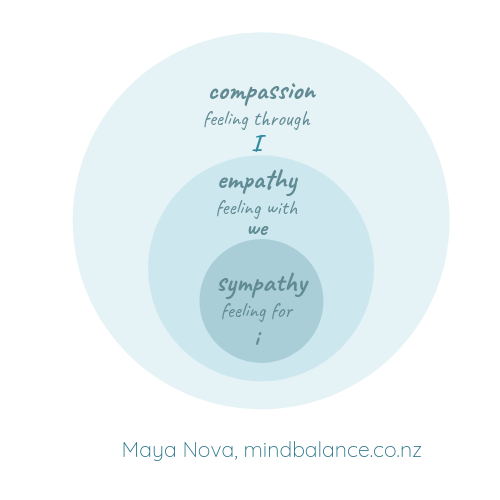The ability to meaningfully connect with others is at the heart of all successful relationships. We do this through feelings of sympathy, empathy and compassion.
Sympathy is feeling for; we could say that sympathy comes from i, our small sense of self or our ego. It often expresses itself in feeling sorry for someone; it's driven by comparison and judgment, which make us feel better-off or superior to the person we feel sorry for. Have you ever been infuriated by: "Oh, poor you!" statement? I certainly have. Being on the receiving end of sympathy puts us in the position of being a victim and is disempowering in nature.
Empathy is feeling with; it comes from a place of we, our shared humanity and is characterized by solidarity, kindness, and absence of judgment.
Nursing scholar, Theresa Wiseman defines four attributes of empathy:
1. To be able to see the world as others see it
2. To be non-judgemental
3. To understand another person's feelings, and
4. To be able to communicate the understanding of that person's feeling
Empathy is about standing in someone else's shoes, feeling with his or her heart, seeing with his or her eyes. Not only is empathy hard to outsource and automate, but it makes the world a better place. - Daniel H. Pink
In this short animated clip, Brene Brown explores the idea that sympathy drives disconnection, and empathy enables the connection. She says: "Rarely can a response make something better. What makes something better is a connection."
Compassion is empathy grounded in action. It helps us to feel through the pain with someone in order to come out on the other side. It emanates from the wisdom of the Big I, the transcendent awareness. It is enabling and empowering in nature, and it serves to relieve the suffering.
True compassion means not only seeing the pain of others but being moved to relieve it. - Daniel Goleman
5 step empathy and compassion practice:
If there is someone in your life you struggle find hard to connect with, understand or forgive, you could give this five-step empathy and compassion practice a go.
Bring that person into your mind’s eye and then go through the following five steps:
STEP ONE: With your attention on the person, repeat to your self:
“Just like me, this person is seeking some happiness in his/her life.”
STEP TWO: With your attention on the person, repeat to yourself:
“Just like me, this person is trying to avoid suffering in his/her life.”
STEP THREE: With your attention on the person, repeat to yourself:
“Just like me, this person has known sadness, loneliness and despair.”
STEP FOUR: With your attention on the person, repeat to yourself:
“Just like me, this person is seeking to fulfill his/her needs.”
STEP FIVE: With your attention on the person, repeat to yourself
“Just like me, this person is learning about life.”
- Taken from Resurfacing ©: Techniques for Exploring Consciousness (1994)

